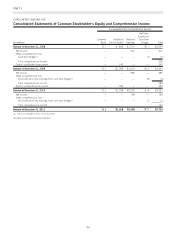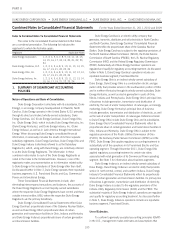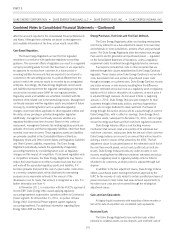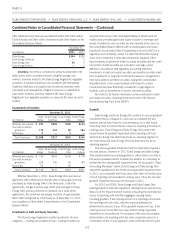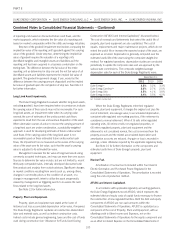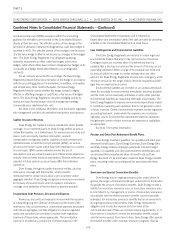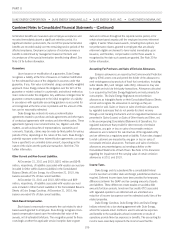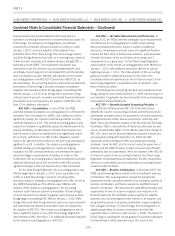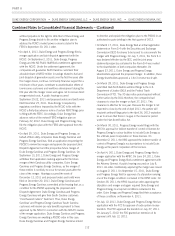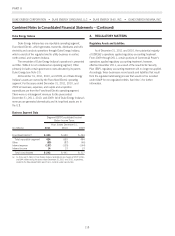Duke Energy 2011 Annual Report Download - page 128
Download and view the complete annual report
Please find page 128 of the 2011 Duke Energy annual report below. You can navigate through the pages in the report by either clicking on the pages listed below, or by using the keyword search tool below to find specific information within the annual report.
PART II
DUKE ENERGY CORPORATION •DUKE ENERGY CAROLINAS, LLC •DUKE ENERGY OHIO, INC. •DUKE ENERGY INDIANA, INC.
Combined Notes to Consolidated Financial Statements – (Continued)
from continuing operations within operating, investing and financing
cash flows within the Consolidated Statements of Cash Flows. With
respect to cash overdrafts, book overdrafts are included within
operating cash flows while bank overdrafts are included within
financing cash flows.
Dividend Restrictions and Unappropriated Retained Earnings.
Duke Energy does not have any legal, regulatory or other
restrictions on paying common stock dividends to shareholders.
However, as further described in Note 4, due to conditions
established by regulators at the time of the Duke Energy/Cinergy
merger in April 2006, certain wholly-owned subsidiaries, including
the Subsidiary Registrants, have restrictions on paying dividends or
otherwise advancing funds to Duke Energy. At December 31, 2011
and 2010, an insignificant amount of Duke Energy’s consolidated
Retained Earnings balance represents undistributed earnings of equity
method investments.
New Accounting Standards.
The following new accounting standards were adopted by Duke
Energy during the year ended December 31, 2011 and the impact of
such adoption, if applicable has been presented in the accompanying
Consolidated Financial Statements:
Financial Accounting Standards Board (FASB) Accounting
Standards Codification (ASC) 605 — Revenue Recognition. In
October 2009, the FASB issued new revenue recognition accounting
guidance in response to practice concerns related to the accounting
for revenue arrangements with multiple deliverables. This new
accounting guidance primarily applies to all contractual arrangements
in which a vendor will perform multiple revenue generating activities
and addresses the unit of accounting for arrangements involving
multiple deliverables, as well as how arrangement consideration
should be allocated to the separate units of accounting. For the Duke
Energy Registrants, the new accounting guidance was effective
January 1, 2011, and applied on a prospective basis. This new
accounting guidance did not have a material impact to the
consolidated results of operations, cash flows or financial position of
the Duke Energy Registrants.
ASC 805 — Business Combinations. In November 2010, the
FASB issued new accounting guidance in response to diversity in the
interpretation of pro forma information disclosure requirements for
business combinations. The new accounting guidance requires an
entity to present pro forma financial information as if a business
combination occurred at the beginning of the earliest period
presented as well as additional disclosures describing the nature and
amount of material, nonrecurring pro forma adjustments. This new
accounting guidance was effective January 1, 2011, and will be
applied to all business combinations consummated after that date.
ASC 820 — Fair Value Measurements and Disclosures. In
January 2010, the FASB amended existing fair value measurements
and disclosures accounting guidance to clarify certain existing
disclosure requirements and to require a number of additional
disclosures, including amounts and reasons for significant transfers
between the three levels of the fair value hierarchy, and presentation
of certain information in the reconciliation of recurring Level 3
measurements on a gross basis. For the Duke Energy Registrants,
certain portions of this revised accounting guidance were effective on
January 1, 2010, with additional disclosures effective for periods
beginning January 1, 2011. The adoption of this accounting
guidance resulted in additional disclosure in the notes to the
consolidated financial statements but did not have an impact on the
Duke Energy Registrants’ consolidated results of operations, cash
flows or financial position. See Note 15 for additional disclosures
required by the revised accounting guidance in ASC 820.
ASC 350 — Intangibles–Goodwill and Other. In September
2011, the FASB amended existing goodwill impairment testing
accounting guidance to provide an entity testing goodwill for
impairment with the option of performing a qualitative assessment
prior to calculating the fair value of a reporting unit in step one of a
goodwill impairment test. Under this revised guidance, a qualitative
assessment would require an evaluation of economic, industry, and
company-specific considerations. If an entity determines, on a basis
of such qualitative factors, that the fair value of a reporting unit is
more likely than not less than the carrying value of a reporting unit,
the two-step impairment test, as required under pre-existing
applicable accounting guidance, would be required. Otherwise, no
further impairment testing would be required. The revised goodwill
impairment testing accounting guidance is effective for the Duke
Energy Registrants’ annual and interim goodwill impairment tests
performed for fiscal years beginning January 1, 2012, with early
adoption of this revised guidance permitted for annual and interim
goodwill impairment tests performed as of a date before
September 15, 2011. Since annual goodwill impairment tests are
performed by Duke Energy as of August 31, the Duke Energy
Registrants early adopted this revised accounting guidance during the
third quarter of 2011 and applied that guidance to their annual
goodwill impairment tests for 2011.
The following new accounting standards were adopted by Duke
Energy during the year ended December 31, 2010 and the impact of
such adoption, if applicable has been presented in the accompanying
Consolidated Financial Statements:
ASC 860 — Transfers and Servicing. In June 2009, the FASB
issued revised accounting guidance for transfers and servicing of
financial assets and extinguishment of liabilities, to require additional
information about transfers of financial assets, including securitization
transactions, as well as additional information about an enterprise’s
continuing exposure to the risks related to transferred financial assets.
This revised accounting guidance eliminated the concept of a
Qualifying Special Purpose Entity (QSPE) and required those entities
which were not subject to consolidation under previous accounting
rules to now be assessed for consolidation. In addition, this
accounting guidance clarified and amended the derecognition criteria
for transfers of financial assets (including transfers of portions of
108



